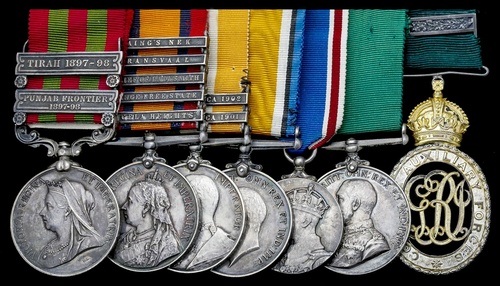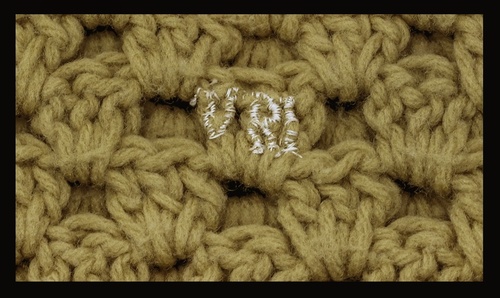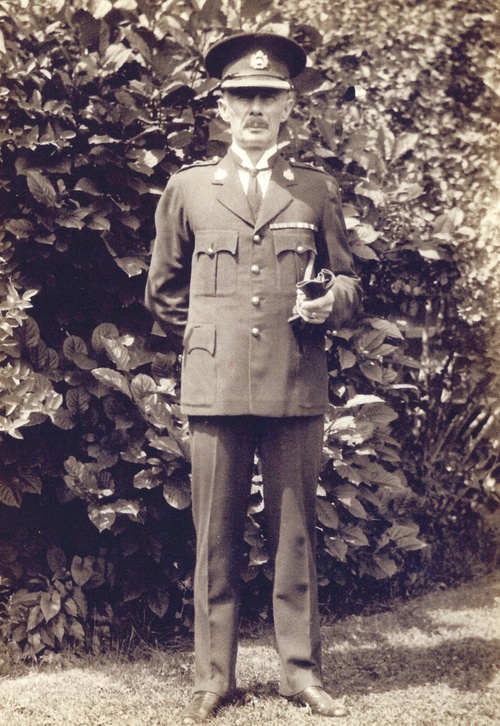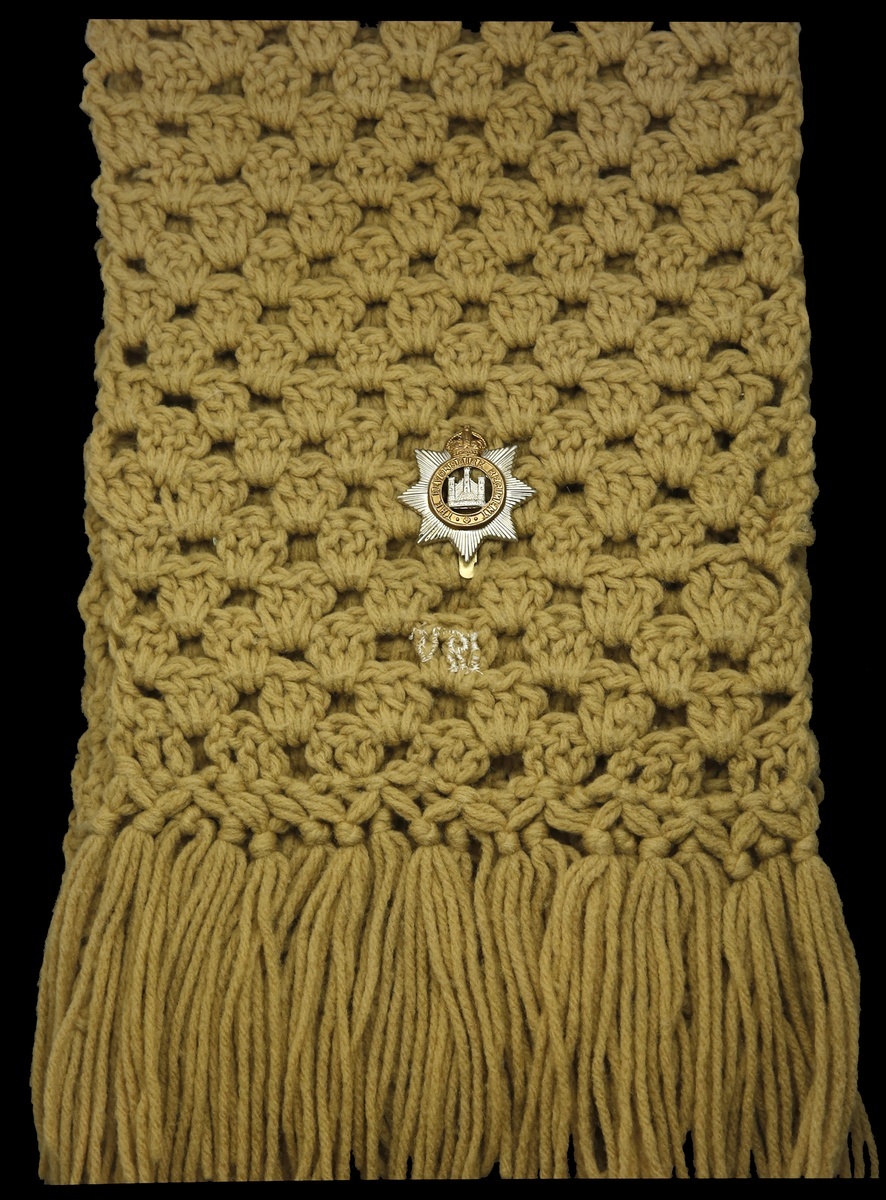Auction: 17002 - Orders, Decorations and Medals
Lot: 156
(x) AN INTRODUCTION TO QUEEN VICTORIA'S SCARVES
The eight, crocheted, woollen scarves worked in the last months of her life by Queen Victoria powerfully demonstrate, as nothing else, the affection that she retained for the ordinary soldiers of her British and Imperial armies. That personal bond between the Queen and her sailors and soldiers was particularly manifest in time of war and exemplified, during the War with Russia of 1854-56, by the creation of the Victoria Cross - in the details of which the Queen took a personal interest - and the foundation of the Royal Victoria Military Hospital at Netley, Hampshire. The Queen made a particular point of personally awarding both the first V.C.'s and the earliest issue of the Crimean War Medal, while also commissioning a series of photographs of 'Heroes of the Crimea' for the Royal Collection. The creation of the Indian Army in 1861 and the development of the Empire's military forces brought ever more exotic soldiers under the Royal and Imperial gaze. By the time of the outbreak of the second South African War in 1899, Victoria had been queen for sixty-two years and while initial British military setbacks in the first weeks of the war may have surprised her, they did not daunt her faith in her soldiers: 'we are not interested in the possibilities of defeat', she is said to have remarked, 'they do not exist'.
Victoria's feeling for her sailors and soldiers was deep-rooted. She was the only child of a soldier-prince, Edward, Duke of Kent; she was the niece of a Royal duke, and monarch, who made a career as a sailor - William IV; she was also the niece of two other Royal dukes, Cambridge and Cumberland, who were career soldiers; George, 2nd Duke of Cambridge, commander-in-chief of the British Army 1856-95, was her cousin. Her inheritance was a military one - King George II having not only fought under Marlborough but also been the last British King to command his troops in battle - and her descendants have maintained a proud and dutiful tradition of naval and military service: noblesse oblige indeed.
The second South African War galvanised the Queen's military philanthropy to a hitherto unseen extent. Never before had she sent her soldiers Christmas presents - as she did with the tins of chocolate sent out at the end of 1899. Never before had she crocheted scarves for particular presentation to soldiers selected by their comrades as being worthy of the honour of their receipt. Victoria, with more than sixty years of experience of her sailors and soldiers, and of their undoubted worth and loyalty to her, clearly understood that, for the ordinary serviceman, the respect of his peers - his mates - was held in far higher esteem than any mention-in-despatches bestowed by some distant General. This understanding undoubtedly underpinned her resolution that her personal gift of her Scarves should be decided by ballot among the recipients' peers; much the same provision could, on occasion, decide the award of the V.C.
The eight woollen scarves that she crocheted in her closing days, her eyesight weakening and her fingers fumbling with the crochet-hook, are the last demonstration of her affection for her soldiers - hard-pressed but stubbornly gallant, as always - during the last war of her reign. That she was even-handed in specifying their distribution - four to British soldiers and four to Colonial soldiers - represents her appreciation of her soldiers' efforts, no matter what their origin. She also well knew that those who did the bidding of her politicians and Generals were likely to be those who suffered most and who received the fewest rewards.
Hence her Scarves: worked by her own hand and, equally significantly, given to soldiers who were voted by their comrades as having deserved them: a Royal as well as a democratic accolade - and all the more worthy for that.
This Scarf described below is one of only eight: a long-treasured possession in the family of its recipient and accompanied by medals indicative of a military career symptomatic not only of so much about Victoria's empire but also of the contribution made by the Dominion of Canada to Imperial defence.
Sold by Order of a Direct Descendant
An exceptionally rare and emotive 'Queen Victoria's Scarf' and related Honours & Awards bestowed upon Lieutenant-Colonel W. T. Colclough, Colonial Auxiliary Forces, late Devonshire Regiment
Of the eight scarves carves personally crocheted by the Queen, four were given to soldiers of the Colonial forces: three of these are in the war museums of Australia, Canada and New Zealand and the location of the fourth is unknown
Four were given to soldiers of the 2nd Brigade, 1st Division, of the British Army: two may have been destroyed in the fire at the Surrey Infantry Museum at Clandon Park in April 2015 and the location of one is unknown
The example offered here is the only one known to survive in private hands
The Scarf:
Of light khaki Berlin wool, crocheted in a variant of 'Ball Pattern', approximately 8½ inches (21cm) wide and sixty-four inches (162cm) long, including 4 inches of woollen fringe at either end; a 'ball' at one end embroidered in white silk with the Imperial Cypher VRI, above which is placed - as attached to the scarf by the recipient's eldest son some 50 years ago - an Other Rank's peaked forage cap badge of The Devonshire Regiment of post-1902 date
The Honours & Awards:
Seven: India General Service 1895-1902, 2 clasps, Punjab Frontier 1897-98, Tirah 1897-98 (2776 Lce. Sergt. T. Colclough, 1st Bn. Devon Regt.); Queen's South Africa 1899-1902, 5 clasps, Tugela Height, Orange Free State, Relief of Ladysmith, Transvaal, Laing's Nek (2776 Sgt. W. Colclough, Devon. Regt.); King's South Africa 1901-02, 2 clasps, South Africa 1901, South Africa 1902 (2776 Serjt. W. Colclough, Devon Regt.); British War Medal 1914-20 (Major W. T. Colclough); Coronation 1937; Colonial Auxiliary Forces Long Service, G.V.R. (Major W. T. Colclough, Winn. L.I.); Colonial Auxiliary Forces Decoration, G.V.R., the reverse of the Crown officially inscribed, 'Lt. Col. W. T. Colclough, Winn. L.I.', somewhat bent and loose suspension post on the first, otherwise generally very fine or better (7)
William Thomas Colcough was born in Birmingham on 27 October 1872. He was described as a 'pearl button maker' when, in Birmingham in September 1889, he enlisted into the 3rd (Militia) Battalion, The Warwickshire Regiment. He was aged not quite 17 but described himself as being 18 (the regulation minimum age for a soldier-recruit). He lasted 15 days before being bought out, probably by his parents. Clearly determined to be a soldier, he re-enlisted at Aldershot on the day before his 17th birthday, 26 October 1889. Again, he described himself as aged 18 but such practices were often winked-at by recruiting sergeants confronted by likely lads. His unit of choice was The Devonshire Regiment and thus he became A Soldier of The Queen, signing-on for what was then the usual Short Service period, '7 years with the Colours and 5 years in the reserve'; it was the beginning of more than sixty years of military service to the Crown.
He remained at home with the 1st Battalion until January 1891, taking the opportunity to acquire his 3rd class certificate of education in November 1890. Late in January 1891, he accompanied the 1st Battalion to Egypt, during which posting he earned an extra penny a day Good Conduct Pay, his 2nd class certificate of education and a Lance-Corporal's chevron, or 'stripe'. Colclough accompanied the Battalion to India late in December 1892 and while there acquired his second stripe, as a Corporal, an extra twopence a day Good Conduct Pay and promotion to Lance-Sergeant. He also acquired his first experience of active service, fighting with the Battalion as part of the Mohmand Field Force and the Tirah Field Force against insurgents among the tribes on the North-West Frontier in 1897. His time with the Colours having expired by early 1898, he returned to England and was posted to the Army Reserve.
The outbreak of war in South Africa saw him summoned back to the Colours and he was recalled to his regiment's 2nd Battalion in the rank of Sergeant as it mobilised for war, at Aldershot in early October 1899. The Battalion embarked from Southampton on 21 October, disembarking at Durban on 19 November. Exact details of Colclough's service are not available but it is clear from the clasps attached to his Queen's South Africa Medal that he was in the thick of the action with his battalion from the end of 1899 for the remainder of the Battalion's war. That he earned the respect of his comrades is beyond doubt since it was they who voted, almost unanimously, that he was the one N.C.O. in the Battalion most deserving of the Queen Victoria's Scarf allocated to 2nd Battalion, The Devonshire Regiment: as the C.O's Battalion Order issued as Karroo Bridge on 24 August 1900 put it:
'Queen's Scarf
The Commanding Officer having considered the names of the eight N.C.Os and men as candidates for the Queen's Scarf has selected No. 2776 Sgt. W. Colclough.
L. Bols, Capt.
Adjutant'
After the end of the war, in June 1902, Colclough and the other reservists returned home: he was 'struck off the strength' on 11 August, having amassed a total of nearly 13 years service with the Colours.
Almost immediately upon leaving the Army, he married - Florence Mary Griffiths - and, shortly afterwards, emigrated to Canada: the Census of 1921 shows that he and his wife arrived in the Dominion in 1903. It seems likely that their first destination was the province of Manitoba, since their eldest son - George - was born there, probably in Winnipeg, in 1904.
Colclough never got soldiering out of his blood: his Canadian army service records state that, by 1915, he had served a total of 10½ years in three regiments of the Canadian Non-Permanent Active Militia: this suggests that he enlisted as a part-time soldier as soon as the family was settled in Canada. His first regiment was the 90th Winnipeg Rifles, in which he served 2 years, probably as an N.C.O.; his second was the 15th Light Horse, based in Calgary, in which he served 3½ years, again, probably as an N.C.O. Finally, having returned to Winnipeg in about 1909-10, he served in the 13th (Winnipeg) Battery, Canadian Field Artillery for 5 years. By the outbreak of the Great War the family was settled in Winnipeg, where Colclough was employed by the city as an Inspector of its markets.
Colclough's service records show that he enlisted into the 53rd Battalion, Canadian Expeditionary Force (C.E.F.), at Prince Albert, Saskatchewan, on 1 April 1915; that battalion was mobilised in Winnipeg. At that time, he appears to have been serving in the 106th Winnipeg Light Infantry, raised in September 1914, but in order to serve overseas enlistment in a C.E.F. battalion was necessary; he was commissioned Lieutenant in the 106th Winnipeg Light Infantry in September 1916. His rank in the 53rd Battalion, C.E.F. was that of Captain but he transferred, as Major and second-in-command, to the 108th Battalion, C.E.F. in December 1915. After training, the Battalion sailed from Halifax, Nova Scotia, for England on 18 September 1916, arriving in Liverpool a week later.
Colclough left England for France on 23 December 1916, attached to the 47th Battalion, C.E.F. on an instructional tour, but he returned to England and the 108th Battalion on 7 January 1917, and moved to the 14th (Reserve) Battalion, C.E.F. at Dibgate Camp, near Folkestone, three days later: as a consequence - and as verified by official records - his sole entitlement was the British War Medal 1914-20.
Thus ended his active service during the war and he returned to Canada in October 1917, to be retired - in the rank of Major - at the end of that month, his rank being confirmed on 1 November 1917. It is possible that he was considered unfit for the rigours of active service by 1917 (he was aged 45) but that did not end his military career: still a Major, he became second-in-command of the Winnipeg Light Infantry (W.L.I.) in 1922, being promoted Lieutenant-Colonel commanding the regiment in February 1928, in the October of which year he was awarded the Colonial Auxiliary Forces Decoration. He remained in command of the W.L.I. until 1931, transferring to command the 2nd Battalion of the Canadian Reserve. In 1940, by which time he was living in Calgary, he joined the board of governors of the Southern Alberta branch of the Canadian Corps of Commissionaires, a body dedicated to finding employment for retired servicemen, and between 1945 and 1952 was chairman of that board.
William Thomas Colclough dedicated his adult life to soldiering, serving every British monarch from Queen Victoria to our present Queen in some capacity linked with the Armies of the Crown. By such dedicated service are people judged and, sometimes, rewarded. The nature of Colclough's character was clearly evident to his peers in 1900, when they voted for him to be the most appropriate recipient of one of Queen Victoria's Scarves. That that character remained unchanged should be evident from the preceding paragraphs. He died on 31 January 1955 and, appropriately, is buried in the Field of Honor, Burnsland Cemetery, Calgary.
Sold with a quantity of supporting documentation, including:
(i)
An old hand written copy of the Battalion Order signed by the C.O. 2nd Battalion, Devonshire Regiment, in which it is stated that he had chosen Sergeant Colclough from the list of names put forward for consideration of receiving the Queen's Scarf; as quoted above.
(ii)
A 2-page hand written account of the circumstances behind the presentation of the recipient's scarf, ink, in his own hand; this states that he received his scarf from Lieutenant-Colonel H. Batson of the Devons - on behalf of the Queen - at a special parade held on 3 September 1900.
(iii)
Assorted family correspondence with the Devonshire Regiment Museum, Winnipeg press, etc., a large quantity of related newspapers reports, and several photographs.
(iv)
Copied British and Canadian army service records.
Additional reference sources
Harfield, Alan, 'Queen Victoria's Scarves', O.M.R.S. Journal Vol. 32, No. 2 (219) (Summer, 1993), pp. 154-163.
Subject to 5% tax on Hammer Price in addition to 20% VAT on Buyer’s Premium. For more information please view Terms and Conditions for Buyers.
Sold for
£13,000











